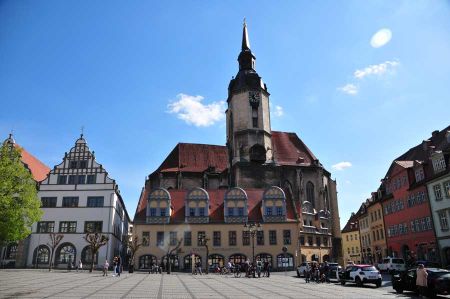A walk through the old town of Naumburg
- Written by Portal Editor
The research for an ATM machine led us into the city centre of Naumburg in southern Saxony-Anhalt for the first time, whose landmark, the early Gothic cathedral of St. Peter and Paul, is one of the most valuable European monuments today.
Naumburg has a well preserved and worth seeing old town with numerous medieval, renaissance, and baroque buildings. The relatively small town is amazingly rich in sights and has retained its leisureliness despite being open to tourists today. In his novel Doctor Faustus, Thomas Mann created a literary monument for her under the name Kaisersaschern.
St. Peter and Paul Cathedral is now a UNESCO World Heritage Site
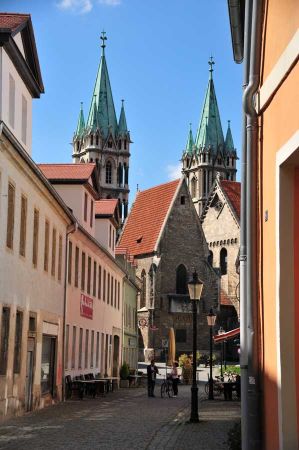 The main attraction of Naumburg is clearly the late Romanesque Naumburg Cathedral with its remarkable donor figures, which has been a UNESCO World Heritage Site since 2018. The construction of the three-aisled, two-choir basilica with four towers and a cloister had started being built already before 1213. The early Gothic west choir was built around 40 years later around 1250. In the first half of the 14th century, the east choir was expanded in high Gothic style. The Romanesque crypt under the east choir dates from around 1170 and was part of a previous building. The pulpit dates from 1466. The south-west tower was completed in 1884. The cathedral was completely restored between 1960 and 1968 but now was closed due to the corona pandemic.
The main attraction of Naumburg is clearly the late Romanesque Naumburg Cathedral with its remarkable donor figures, which has been a UNESCO World Heritage Site since 2018. The construction of the three-aisled, two-choir basilica with four towers and a cloister had started being built already before 1213. The early Gothic west choir was built around 40 years later around 1250. In the first half of the 14th century, the east choir was expanded in high Gothic style. The Romanesque crypt under the east choir dates from around 1170 and was part of a previous building. The pulpit dates from 1466. The south-west tower was completed in 1884. The cathedral was completely restored between 1960 and 1968 but now was closed due to the corona pandemic.
The twelve donor figures in the west choir that were created later than 1250 are world famous. All figures are life-size and carved in limestone. The best-known figures are the ones of Uta von Ballenstedt and Ekkehard II. von Meißen on the north side of the west choir, and Regelindis and Herrmann I opposite on the south side. They are among the earliest realistic depictions of individual faces in the European Middle Ages. The figure of Uta is sometimes called the "most beautiful woman of the Middle Ages" and Umberto Eco wrote about her: "If you ask me which woman in the history of art I would eat with and spend an evening with, there would be Uta von Naumburg first. "
Renaissance town hall and Kaysersches Haus
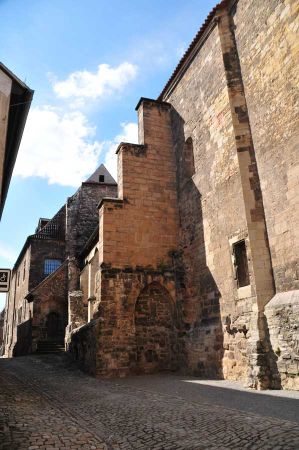 In the medieval town-centre, in addition to the Renaissance town hall (1517 to 1528) with the Ratskeller, there is the striking Kaysersche Haus with three Renaissance gables and the late Gothic town church St. Wenzel. This three-aisled hall church was built between 1517 and 1523 and was restored in 1945 after it was damaged. Its interior was redesigned in 1724. The organ was personally examined by Johann Sebastian Bach and can be heard regularly in concerts after its elaborate restoration. In the side streets there are characteristic town houses with beautiful gables.
In the medieval town-centre, in addition to the Renaissance town hall (1517 to 1528) with the Ratskeller, there is the striking Kaysersche Haus with three Renaissance gables and the late Gothic town church St. Wenzel. This three-aisled hall church was built between 1517 and 1523 and was restored in 1945 after it was damaged. Its interior was redesigned in 1724. The organ was personally examined by Johann Sebastian Bach and can be heard regularly in concerts after its elaborate restoration. In the side streets there are characteristic town houses with beautiful gables.
From the market square, the Marienstraße leads north to Marientor. This city gate, dating from the 15th century, is the only one of former 7 city gates that has been preserved and is equipped with an external gate, rampart, internal gate and guard tower.
Small tram in front of the central station
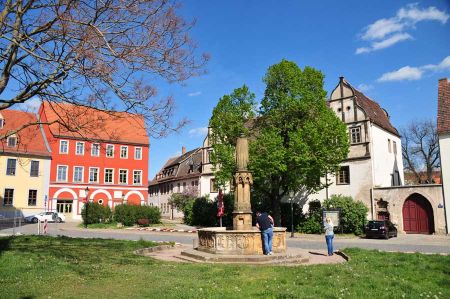 The Naumburg tram, which has been preserved in parts, runs halfway around the city centre from the main train station every 30 minutes (single trip 2 €, reduced 1 €; sales also in a car, association tickets are accepted). Historic vehicles built in Gotha from the 1950s to the 1970s are used. If you are lucky, you can also drive the Lindner railcar built in 1928.
The Naumburg tram, which has been preserved in parts, runs halfway around the city centre from the main train station every 30 minutes (single trip 2 €, reduced 1 €; sales also in a car, association tickets are accepted). Historic vehicles built in Gotha from the 1950s to the 1970s are used. If you are lucky, you can also drive the Lindner railcar built in 1928.
The connection between the actual Naumburg and the district Großjena im Blütengrund, a meadow landscape lined with vineyards at the confluence of the Saale and Unstrut rivers, creates a non-motorized passenger ferry from March to October, which is only driven by the flow energy of the water (due to the leading route along it) Bike path is possible).
Nietzsche monument with curious girl
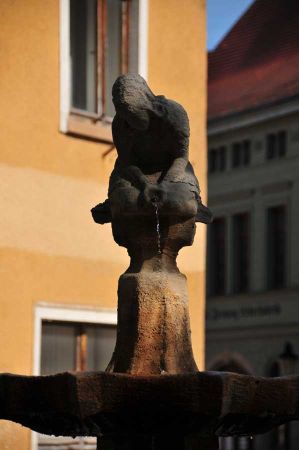 The philosopher Friedrich Nietzsche (1844–1900) spent his childhood, youth and his last years in Naumburg. An exhibition in the Nietzsche House, Weingarten 18, his former home, is dedicated to him. Immediately behind it is the Nietzsche Documentation Centre in a new building, where researchers collect and process Nietzsche's intellectual heritage. Here too there are changing exhibitions and events. 200 meters from the Nietzsche house, on the timber market, there is a monument that shows Nietzsche in dialogue with a curious girl.
The philosopher Friedrich Nietzsche (1844–1900) spent his childhood, youth and his last years in Naumburg. An exhibition in the Nietzsche House, Weingarten 18, his former home, is dedicated to him. Immediately behind it is the Nietzsche Documentation Centre in a new building, where researchers collect and process Nietzsche's intellectual heritage. Here too there are changing exhibitions and events. 200 meters from the Nietzsche house, on the timber market, there is a monument that shows Nietzsche in dialogue with a curious girl.
The house of the sculptor, painter and graphic artist Max Klinger (1857–1920) is located in the Großjena district, open from end of March to end of October Tue-Sun 10 am–5pm. Nearby you will find the “stone picture book” created around 1722, a series of 12 reliefs carved into the upcoming sandstone cliffs, which mostly depict scenes from the Bible. Both are located in Blütengrund on the Unstrut, you can reach them on a less than one kilometre walk from the car park at the Blütengrund campsite after crossing the Saale by ferry.
We were surprised to find such a large number of well-preserved or valuable restored historical buildings and their colourful gables, especially since the wonderful sunshine causes impressive light, which made the colours shine. Despite Corona (or maybe because of it), an ice cream parlour received a lot of encouragement, including us. There is so much more to see here that further visits will be pending.
Please read as well:
Imposing graduation plant in Bad Kösen on Saale river
Hanseatic city of Stendal - Brick Architecture and History
-
 Hike through beautiful medieval Naumburg
Hike through beautiful medieval Naumburg
Hike through beautiful medieval Naumburg
Hike through beautiful medieval Naumburg
-
 Hike through beautiful medieval Naumburg
Hike through beautiful medieval Naumburg
Hike through beautiful medieval Naumburg
Hike through beautiful medieval Naumburg
-
 Hike through beautiful medieval Naumburg
Hike through beautiful medieval Naumburg
Hike through beautiful medieval Naumburg
Hike through beautiful medieval Naumburg
-
 Hike through beautiful medieval Naumburg
Hike through beautiful medieval Naumburg
Hike through beautiful medieval Naumburg
Hike through beautiful medieval Naumburg
-
 Hike through beautiful medieval Naumburg
Hike through beautiful medieval Naumburg
Hike through beautiful medieval Naumburg
Hike through beautiful medieval Naumburg
-
 Hike through beautiful medieval Naumburg
Hike through beautiful medieval Naumburg
Hike through beautiful medieval Naumburg
Hike through beautiful medieval Naumburg
-
 Hike through beautiful medieval Naumburg
Hike through beautiful medieval Naumburg
Hike through beautiful medieval Naumburg
Hike through beautiful medieval Naumburg
-
 Hike through beautiful medieval Naumburg
Hike through beautiful medieval Naumburg
Hike through beautiful medieval Naumburg
Hike through beautiful medieval Naumburg
-
 Hike through beautiful medieval Naumburg
Hike through beautiful medieval Naumburg
Hike through beautiful medieval Naumburg
Hike through beautiful medieval Naumburg
-
 Hike through beautiful medieval Naumburg
Hike through beautiful medieval Naumburg
Hike through beautiful medieval Naumburg
Hike through beautiful medieval Naumburg
-
 Hike through beautiful medieval Naumburg
Hike through beautiful medieval Naumburg
Hike through beautiful medieval Naumburg
Hike through beautiful medieval Naumburg
-
 Hike through beautiful medieval Naumburg
Hike through beautiful medieval Naumburg
Hike through beautiful medieval Naumburg
Hike through beautiful medieval Naumburg
-
 Hike through beautiful medieval Naumburg
Hike through beautiful medieval Naumburg
Hike through beautiful medieval Naumburg
Hike through beautiful medieval Naumburg
-
 Hike through beautiful medieval Naumburg
Hike through beautiful medieval Naumburg
Hike through beautiful medieval Naumburg
Hike through beautiful medieval Naumburg
-
 Hike through beautiful medieval Naumburg
Hike through beautiful medieval Naumburg
Hike through beautiful medieval Naumburg
Hike through beautiful medieval Naumburg
https://www.alaturka.info/en/germany/saxony-anhalt/5089-a-walk-through-the-old-town-of-naumburg#sigProId3130fb65a8
